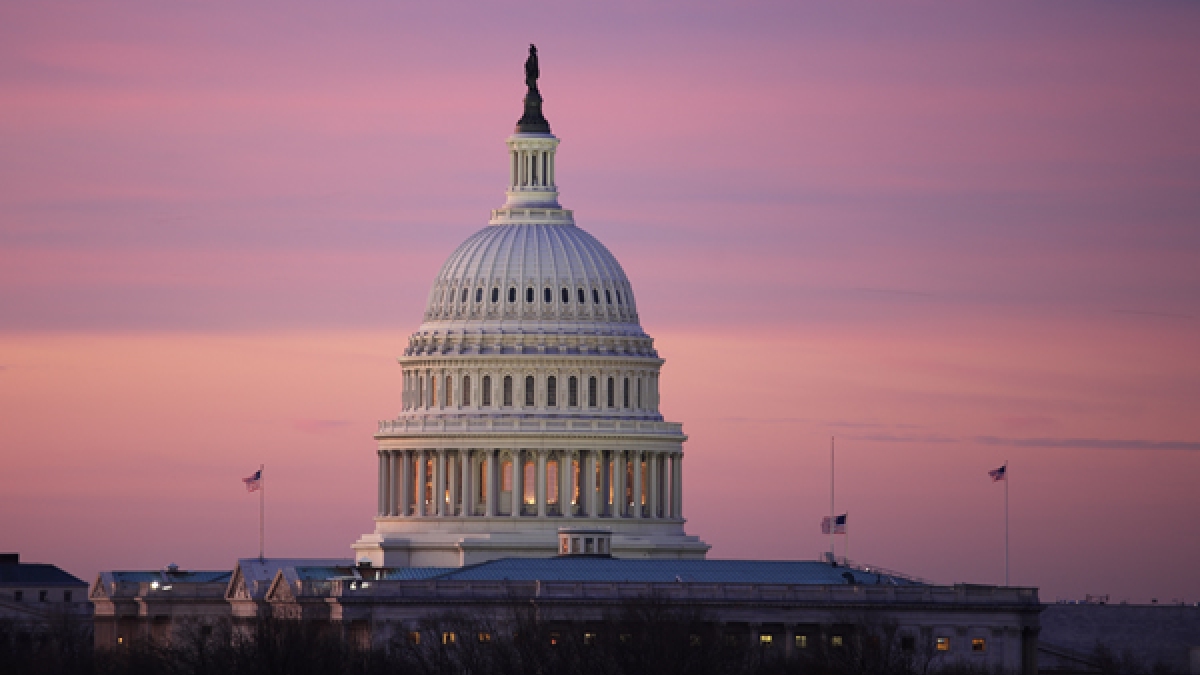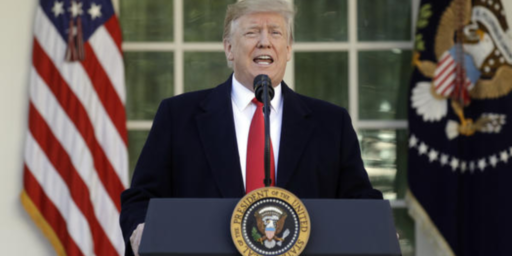House Passes Bill To Block Trump’s Emergency, With Minimal GOP Support
The House of Representatives voted yesterday to block the President's declaration of an "emergency" at the southern border. Now the matter goes to the Senate.

As expected, late yesterday the House of Representatives voted to block the President’s declaration of a “national emergency” at the southern border but it did so with only token support from House Republicans:
WASHINGTON — The House voted on Tuesday to overturn President Trump’s declaration of a national emergency on the Mexican border, with just 13 Republicans joining Democrats to try to block his effort to divert funding to a border wall without congressional approval.
House Republican leaders kept defections low after feverishly working to assuage concerns among rank-and-file members about protecting congressional powers and about the precedent that Mr. Trump could be setting for Democratic presidents to use for their own purposes.
“Is your oath of office to Donald Trump or is it to the Constitution of the United States?” Speaker Nancy Pelosi asked her Republican colleagues in a speech on the floor ahead of the vote. “You cannot let him undermine your pledge to the Constitution.”
The resolution of disapproval, which passed 245 to 182, must now be taken up by the Senate, where three Republicans have already declared their support, only one short of the number needed for Congress to ratify a stinging rebuke of Mr. Trump’s efforts.
It remains highly unlikely that opponents will muster the votes to overturn a promised veto of the resolution. But final passage of a measure to assert Congress’s constitutional authority over spending is sure to bolster numerous lawsuits that maintain that Mr. Trump’s declaration is an unconstitutional end run around Congress’s lawful power of the purse.
Many of the 13 Republicans who defected in the House were adamant in their arguments. Representative Jim Sensenbrenner of Wisconsin, a veteran lawmaker who once helped manage Republican efforts to remove Bill Clinton from the White House, made it clear he supported the border wall.
But, he said, “insufficient action — however frustrating it may be — is still the prerogative of the legislative branch. It is imperative that no administration, Republican or Democratic, circumvent the will of Congress.”
(…)
Democrats, who overwhelmingly endorsed the resolution of disapproval, framed the vote as an ultimatum on whether lawmakers would buck party loyalty in order to protect Congress’s constitutionally granted powers. Ms. Pelosi, in a floor speech on Tuesday, listed a number of instances in which House Republicans had objected to Mr. Obama’s use of executive power, vowing that “we are not going to give any president, Democratic or Republican, a blank check to shred the Constitution of the United States.”
Representative Joaquin Castro called the vote on the one-page resolution “the most important vote, probably in a generation, on the separation of powers.”
Mr. Castro, Democrat of Texas and the author of the resolution, warned Republicans that if the president’s declaration went unchallenged, the issue would resurface.
“If Congress lets this stand, if the courts let it stand, how am I to tell a future president that gun deaths that number in the tens of thousands every year in this country, or opioid deaths that number in the thousands in this country, are not an emergency?” Mr. Castro said in a brief interview. “Or climate change is not a national emergency?”
“If this becomes a short circuit to get other things done,” he added, “then how is a president not expected to use that tool in the future?”
The debate over the merits of Mr. Trump’s national emergency declaration has led some lawmakers to suggest that Congress should re-evaluate how much power it has shifted to the executive branch and the scope of the National Emergencies Act.
“The larger issue is Congress has delegated its authority to the White House in hundreds of instances,” said Senator John Cornyn, Republican of Texas. “I think we need to have a bigger conversation about the separation of powers and whether we want to continue to delegate all this authority to the next president.”
More from The Washington Post:
The House on Tuesday passed a resolution to overturn President Trump’s declaration of a national emergency on the southern border, as majority Democrats painted an apocalyptic portrait of a lawless chief executive out to gut the Constitution.
The 245-to-182 tally was mostly along party lines, with 13 Republicans defecting to side with Democrats on a vote that effectively became a test of GOP loyalty to Trump. Despite their frequent complaints of executive overreach during the Obama administration, most Republicans fell in line with Trump’s decision to try to circumvent Congress to get billions of dollars for his border wall. As a result, the vote fell well short of the two-thirds majority that would be required to overcome Trump’s threatened veto.
Democrats argued that Trump’s claim of a crisis at the border was baseless and that he was embarking on the road to dictatorship by unilaterally declaring an emergency to try to get money from U.S. taxpayers to fulfill an unpopular campaign promise.
“We are not going to give any president, Democratic or Republican, a blank check to shred the Constitution of the United States,” House Speaker Nancy Pelosi (D-Calif.) said on the floor ahead of the vote. Holding up a pocket copy of the Constitution, she asked Republicans: “Is your oath of office to Donald Trump or is your oath of office to the Constitution of the United States?”
Republicans countered that Democrats were ignoring a real crisis at the border and said that Trump was well within his rights to declare a national emergency, since he was acting under provisions of a law passed by Congress, the National Emergencies Act of 1976. Tuesday’s vote was the first time since passage of the law that Congress has invoked provisions allowing for a resolution of disapproval to nullify a presidential emergency declaration.
“There is a national emergency at the southern border that the Democrats will declare today doesn’t exist,” said House Minority Leader Kevin McCarthy (R-Calif.). “The president has the authority to do it, and we will uphold him.”
Trump issued the emergency declaration Feb. 15, as part of a deal to keep the government open after a 35-day partial shutdown over Christmas and much of January. The president agreed to sign a spending bill that keeps the government funded through Sept. 30 and provides $1.375 billion for 55 miles of fencing along the border in Texas, but he said he needed billions more. The administration plans to redirect an additional $6.7 billion from several sources, including $3.6 billion from military construction projects that can be accessed via the emergency declaration.
Trump had long claimed that Mexico would pay for the wall.
(…)
Many Republicans who had argued against executive overreach when Obama was in office said Tuesday that the situation is different now, since Trump drew his authority to declare a national emergency from a federal law that also gives Congress the power to overturn his action.
One GOP lawmaker, however, offered a dissenting view.
“I’ll be real honest, if Obama had done this, Republicans would be going nuts. That’s just the reality,” said Rep. Mike Simpson (R-Idaho). “Even if Obama had the authority to do it, just like I think President Trump does.”
Nonetheless, Simpson voted with the president and against the disapproval resolution, saying the National Emergencies Act gave Trump the authority to act as he did. Simpson did say the law itself should be revisited.
The disapproval resolution consists of only one paragraph, which says the national emergency Trump declared “is hereby terminated.”
As noted, thirteen Republicans ended up joining with House Democrats to vote for the disapproval resolution. The list includes Members of Congress who have stood out as conservative and libertarian-leaning iconoclasts such as Representatives Justin Amash (Mich.), Dusty Johnson (S.D.), Thomas Massie (Ky.) and F. James Sensenbrenner Jr. (Wis.). The remaining nine are considered more moderate and/or represent “swing” districts and parts of the country where the President is not popular including Representatives Jamie Herrera Beutler (Wash.), Brian Fitzpatrick (Pa.), Mike Gallagher (Wis.), Will Hurd (Tex.), Elise Stefanik (N.Y.), Francis Rooney (Fla.), Greg Walden (Ore.), Fred Upton (Mich.) and Cathy McMorris Rodgers (Wash.). McMorris Rogers stands out a bit because she is a former member of House Leadership who was on President Trump’s short list to become Secretary of the Interior after the 2016 election. These thirteen represent just 6.6% of the Republican House Caucus. The remaining 184 Republican Members of Congress all voted against the resolution and many of them delivered speeches on the floor defending the action.
While the lack of Republican support is disappointing, it’s hardly surprising. The Republican Party made its choice between the Constitution and the country and Trump and the GOP when they rallied behind Trump as a candidate even while knowing what he was and what he stood for and they have stood behind him ever since. As I noted yesterday, the GOP has become, in more ways than one, the Party of Trumpism, something that yesterday’s vote in the House makes clear. This is why the thirteen members of the Republican House Caucus who did choose their country over their party deserve our thanks and our appreciation. It’s unfortunate they weren’t joined by more members of their party.
From here, the resolution goes to the Senate, which according to provisions set forth at 50 U.S.C. 1622 must refer the resolution to the appropriate committee and that this committee must report on the resolution within fifteen days after receiving the resolution. Within three days after that committee report, whether it is positive or negative, the resolution must be brought to the floor of the Senate for a vote. Based on the mandatory language of the statute, the resolution must be voted on by the full Senate, which suggests to me that the matter cannot be filibustered and that the Senate Majority Leader does not have the discretion he ordinarily has regarding whether or not a piece of legislation makes it to the floor for a vote. At that point, if the resolution passes the Senate it next goes to the White House where it can be signed or, as the White House has already threatened, veto the bill. At that point, Congress would have the opportunity to try to override the veto even though it’s already clear from the vote in the House that, due to the craven unity of the Republican Party behind the President, any override attempt would fall far short of the two-thirds majority required by the Constitution.
As far as the resolution’s fate in the Senate goes, that’s still quite up in the air but the headcount is looking good for opponents of the President’s emergency declaration. Given the current 53-47 balance in the Senate, Democrats need at least four Republicans to pass the resolution. So far, it appears from comments made to the media that Senators Thom Tillis of North Carolina, Susan Collins of Maine, and Lisa Murkowski of Alaska have all said that they will vote with the Democrats, so that means that all we need is one more Republican to put the vote over the top. For this reason, the eyes of the nation will be on several Senators that many believe will be crucial to determining whether or not the resolution passes. This includes Senators such as Rand Paul, Ben Sasse, and Mitt Romney who have been critical of Trump in the past, and Tennessee Senator Lamar Alexander who is retiring at the end of the current session of Congress in 2020 and thus may feel free to rebel from the Republican caucus on a vote like this.
While the fate of the resolution in the Senate remains unclear, the fact that the House has stood up against this illegal and unconstitutional power grab by the President is a good thing. There are very few recent examples of Congress standing up against Executive Branch power grabs in the past, and we’ve paid the price for that. One hopes that this is a sign that things are changing in that regard.






Someone please tell me that the Dems are not about to let themselves get played yet again. I see the Senate allowing Trump to get away with this power grab, but, just before the next elections, raising up the rope ladder by putting procedural shenanigans in place to keep the next president from pulling the same stunt. Should ever the political stars align again, they will lower that ladder.
13 is 7% of 184, not .07%
Yay, Michigan – we had two of the Republicans who voted yes.
@Kit: The Dems know the Senate may not pass it and if they do Trump will veto it and override will fail. Then it will go into the courts and with any luck won’t be seen again in Trump’s lifetime. This is all for show. It’s campaigning for 2020 by making the Rs vote, as Doug says, for Trump or for the Constitution. It’s what they can do.
Post-blue wave, the Dems are back to relying on Murkowski and Collins to cross the aisle?
Mostly theater. Don’t tell me they didn’t consult among themselves over who would take the least heat for voting with the Democrats, and what was the minimum number of cross-overs necessary to appear “defensible”. Both Dems and GOP in Congress are unhappy with Trump’s declaration and would prefer it be blocked in the long run. The question is: Who wants to be associated with doing this? I’m sure the GOP Congressional leadership is more than happy to let the Supreme Court kill the order but they’ve got to be worried whether that would actually happen.